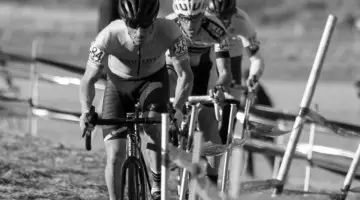
Adam Myerson is off and running here, but may need to hone his hopping skills © Natalia McKittrick, Pedal Power Photography, 2009
Adam Myerson is a longtime racer who has worked his way up to the pro ranks of road and cyclocross racing. As both a competitor and the owner of Cycle-Smart coaching, Myerson knows what goes into maximizing performance on a cyclocross course, but it’s his additional experience as the promoter of the oldest running UCI cyclocross race in North America – the Cycle-Smart International in Northampton, Massachusetts – and as a former member of the UCI Cyclocross Commission that gives him a comprehensive perspective on the sport that’s tough to match. Who better to talk to about the several significant changes to the UCI rules regarding cyclocross for 2010 / 2011?
Cyclocross Magazine: Thanks for talking to us, Adam. Let’s look at each of the rule changes separately. I’m interested in what you think the UCI’s intentions wer as well as whether you think the rule changes will achieve those goals. Also, tell us if you’re a fan of the way you think the changes will impact the sport.
Let’s start with disc brakes. I saw on Twitter already that you’re not a fan. (“Disc brakes are for mountain bikes and motorcycles. Not cyclocross bikes.”) Tell me why that is.
Adam Myerson: Part of why I’m not a fan is that I think that you can define a cyclocross bike in a very distinct way. Cyclocross as a sport has a tradition, and that tradition matters to some degree. A cyclocross bike is identifiable by a couple of characteristics: dropped handlebars, narrow tires, cantilever brakes and basically the look of a road bike. When you start to change those things, if you change them in a way that alters what the bike can do or the way the bike gets used, you change the sport in a way that makes it unrecognizable. I don’t think you could restrict something like clipless pedals from cyclocross, for example – that was a very dramatic change from clips and straps. It changed what you could do in ’cross, how hard you could pedal, and the whole technique of how you got on and off your bike and in and out of your pedals, and it made the sport a lot faster. So, while it did change the sport, it wasn’t in any kind of unrecognizable way.
I don’t think disc brakes are going to change the sport in an unrecognizable way, but I think we’re losing some of the differentiation between what a cyclocross bike is and what a mountain bike is. Mountain biking has a spirit of innovation and techincal change, partially because it doesn’t have a long history – and these are things that came up in ’Cross Commission meetings, this is the philosophy essentially espoused by the UCI as well – mountain biking is still defining itself and shaping itself, and one of its hallmarks is innovation and to see what works. ’Cross isn’t that way, it’s a traditional sport that already has a history and personality. There’s something to preserve with cyclocross. As mountain biking became popular, it became increasingly important to differentiate between the two – you don’t want a cyclocross bike and mountain bike to look the same, to ride the same, or to cover the same terrain. I don’t think disc brakes are necessary for cyclocross, and I don’t think they belong on a ’cross bike, and I think they potentially change the characteristics of what you can do on a cyclocross bike, which potentially changes the way the sport goes.
CXM: So, expound on that a bit. What do you think you can do differently with disc brakes and how do you think it could have an impact.
AM: People who are coming to cyclocross from a MTB background will be much more comfortable with disc brakes, they’ll be more familiar with how they work and with how to modulate their braking. There’s no question that they work better in terms of stopping a wheel, and they work better in bad conditions. It’s almost too much power and not enough technique. One of the things that’s beautiful about ’cross is the art aspect, the technique aspect. You have to have some technique and some form, and it’s not easy. It’s not like I want people to have worse brakes to make ’cross more interesting, it’s just a change that in my opinion we didn’t necessarily need. It comes down to tradition, and cantilever brakes are a part of the tradition of the way cyclocross bikes work.
I don’t see tons of people switching to disc brakes, and I don’t necessarily think this will hurt cyclocross – I just think it’s muddying the water and making things more complicated.
CXM: Do you anticipate that you’ll be using disc brakes this coming season or some time in the future?
AM: No, absolutely not. I don’t see any reason to. As the technology currently stands, we know that disc brakes are heavier, having an arsenal wheels will be more expensive and more specific with discs. One thing that’s great about ’cross is that it’s based on accessible low technology. Not that disc brakes are an advanced unattainable technology, but if you’re showing up to a race with an arsenal of wheels, and every wheelset will cost however many hundreds of dollars more, I think that becomes a problem. I’ve never had a complaint with my brakes, I’ve never had braking be a limiter in cyclocross. There have been times on early carbon rims that didn’t have great braking surfaces in muddy races with steep downhills, but braking surfaces have improved on carbon rims, brake pads have improved, and one way you solve that is going with aluminum rims, which gives you durable, affordable, light enough wheels that will get you through a cyclocross season.
Here’s who I think’s going to ride discs: new riders who buy a bike for the first time who come from a MTB background. Also, if you only have one set of wheels and one bike, disc brakes might be a good solution for when it gets really muddy – you’ll still be able to keep riding through conditions like that. It could help the first-time cyclocrosser get going, but I think the first upgrade you might see someone make, almost like taking the training wheels off, is to go into a bike with cantilever brakes that are lighter and that allow you to have multiple wheels at a more affordable price. And those riders will develop the technique to handle those brakes. That’s the second wave. Then the third wave, at the top level of the sport, the only people running disc brakes will be riders with a MTB background or riders with a lot of financial backing and support and equipment sponsors that want to push the disc brake market and will shell out for 10 or 12 wheels.
I like when everyone’s on the same equipment, I like the NASCAR stock elements. I think the UCI’s attitude is, “Let’s open it up and see what happens.” As long as it’s not a safety factor. That was the major delay, waiting for reports to come back in terms of safety. I don’t think you’ll ever see disc brakes approved for the road because of the crash danger and the pileup issue. The exposed disc brake itself is a danger of cutting people in a crash. That’s not a concern in MTBing at all, and it’s less of a concern in cyclocross.
CXM: Do you think it’ll affect course design, maybe with more crazy downhills into tight corners?
AM: No, at least not in America. The reason we don’t have the crazy courses like you see in European World Cups is that you have to have a course that can accommodate the beginner races as well. Even if they have disc brakes, you’re never going to run beginners off of cliffs. Unless beginners are separated out from professionals, I don’t think you’ll see courses designed to be more difficult like that.
CXM: OK, let’s move onto tire widths, which now need to be less than 33mm for the UCI categories (Juniors 17-18, U23, Elites) and for all classes over age 17 at Nationals. Current ‘Cross Commission member Geoff Proctor explained to me that this was at least in part an effort to simplify and to reduce costs for racers. What are your thoughts?
AM: The discussion about making that change had never come up while I was on the Commission, so it was actually news to me. But from the outside, I think it continues to differentiate cyclocross from MTB, which has always been a part of cyclocross’ reform process, which started about ten years ago. We used to always only race on 28s. The 32s and 34s are a relatively modern thing, and they came from MTB racing. When mountain biking started getting popular and people started showing up with 40mm tires, it seemed like the sport was changing in the wrong direction. That’s when we came up with the 35mm maximum width.
By limiting it to 33, it means everyone’s going to run 32s as the maximum width tire, and you cut in half, or maybe by one-third, the number of wheel and tire choices you have to bring to any races. I love the simplicity of taking some choices away, which levels the playing field and cools the equipment arms race to a degree. I think the bike shops will like it since they won’t need to stock as many things. People will go through as many tires in a season as they always do, even though they’ll have fewer wheels, they’ll likely have to go through a similar amount of tires. The manufacturers will be able to focus on fewer models, too.
CXM: It seems to really push people towards tubulars too. The narrower you get, the less viable a clincher becomes.
AM: I’d say that’s probably true. When you run a 35mm clincher, if you get the pressure right you can do a fair bit with it. A 32mm clincher means higher pressure to prevent punctures, which means less traction. You’ll get much better performance out of a tubular at those widths, no question.
Even though it caught me off guard, I like the change in the tire width minimums.
CXM: Let’s talk about the barriers – height now can be up to 40cm, but can be whatever you want below that. Distance apart is four to six meters. Sounds like that potentially could really change the dynamics of a course.
AM: I’m not excited about it. It’s a little of a change of direction, and you have to think about how we got here. We started with no limit to the number of barriers and they only had to be 12 inches high. Then it was 12 to 14 inches, then 40cm. Next they made it 40cm high and four meters apart. That was a direct response to Sven Nys hopping all of the barriers and, the UCI felt, he was winning a lot of his races because he was able to hop the barriers at speed. If you had a situation where in order to be competitive, everyone had to learn to bunnyhop, then you were changing cyclocross. Needing to bunnyhop had never been mandatory to win, but Nys was changing that.
That was also why they reduced the number of barriers – the UCI wanted to move away from situations where, on muddy courses, sometimes competitors were running more than riding. They wanted to make cyclocross fast and move away from running being the emphasis; they wanted it to be a bike race.
There’s still only one set of planks, but that one set of planks can be entirely bunnyhop-able if the promoter wants it that way. It will put us in a situation where, if there are a bunch of guys in the lead group who are as strong as one another, and you can gain five seconds every time by hopping the planks, then only the guys who can hop will remain in the front group. You’re requiring bunnyhopping to be a skill to be competitive at the front of a cyclocross race. I personally haven’t practiced bunnyhopping in five years. I used to hop all the time, but I realized I was faster dismounting than hopping – I could always dismount without crashing, but couldn’t always hop without crashing.
Once the barriers were 40cm and four meters apart, there were very few people who could still hop and it was less of an advantage. But if they’re only 10 or 12 inches and six meters apart, you have to be able to bunnyhop. I know I’ll have to reintroduce bunnyhopping into my technique training this fall. It’ll be a nice spectacle, but I don’t think it’s a great rule for the average cyclocross racer. I’d have liked to see the height and distance of the barriers stay the same, but introduce two or even four sets of planks. That’s what people like, that’s what’s fun.
CXM: What about importing sand, are we going to see a lot more sand in big races now?
AM: No, I think in the US nothing will change. How many promoters have the money to truck in sand and make sand pits? I think in Europe you might see in the big budget races with flat courses, every race will be trucking in sand. That happened before the ban, but now there are restrictions to prevent it from becoming a total spectacle, specifically there needs to be a level entrance (no drop-off) and there’s a restriction on the length.
In the US, we have sand when there’s sand available. We have sand when there’s a beach or a volleyball court, like at the Cycle-Smart race that I put on. Those things were already legal.
Stay tuned to Cyclocross Magazine for more feedback on the new UCI rule changes and, of course, to see how they actually end up impacting the events. For the full explanation of all cyclocross rules, find them here, on the UCI Web site.


























